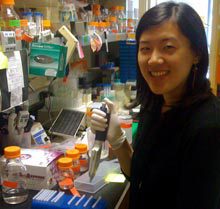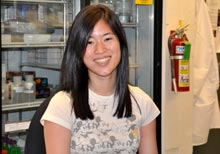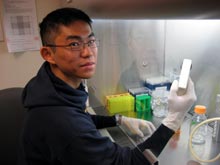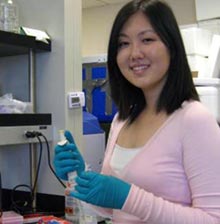Chen Chen

One of the most surprising conclusions to emerge from whole genome sequencing projects in the last decade is that all animals have roughly the same number of genes. Initially, this seems contradictory to the idea that higher organisms have more genes to account for higher levels of complexity. However, one potential explanation is alternative pre-mRNA splicing, through which different exon combinations are incorporated into mature transcripts, thereby increasing the number of proteins encoded by a limited number of genes. Although there have been extensive studies in vitro concerning the biochemical […]
Connie Wang

My research project is designed to tease apart the contribution of circadian irregularities on reproductive performance. Circadian rhythms are essential for the maintenance of ~24 hour cycles in behavior, physiology, and neural function required for normal health. In humans, chronic or acute loss of synchrony between the circadian clock in the brain and the environment through shift work, jet lag, poor sleep hygiene, etc., leads to numerous health problems. Of great concern, many studies show that disruptions in circadian function lead to infertility, spontaneous abortion, and low birth weight in […]
Karlyn DeSteno

All musical compositions borrow some material. It is not always easy for the law to draw the line between theft and inspiration. Recent changes in copyright law point to new systems of valuation of musical elements, both cultural and legal. This summer Ill be tracing these changes through a musical and legal analysis of music written for television and commercials, focusing on compositions which seek to copy elements of other, original works. Ill spend one month in Washington, D.C. using archives at the Library of Congress, and will also conduct […]
John Wang

Muscle fibers are lined with small, non-fiber cells that reside between fiber bundles. These cells are called satellite cells. They are muscle stem cells which repair muscle upon injury. Satellite cells are important for use in stem cell therapies as they can self-renew and maintain their numbers following transplantation. Pax7 is a protein that has previously been reported to be uniquely expressed in satellite cells. As such, it is often used to verify the identity of cells collected from whole muscle biopsies. My project aims to show that Pax7 is […]
Andrew Feher

In an era of globalization where food travels through tortuous production chains before arriving at its destination, too little attention has been given to government regulation. The question driving my research is how do small-scale California farmers involved in rearing animals respond to different forms of government regulation? Given that questions broad scope, I will bifurcate it along two lines: one related to production and one related to political mobilization. On the production side, I am interested in understanding how small-scale farmers adjust production based on various regulations. The political […]
Sierra Weir

My project investigates the Minuteman Civil Defense Corps, a paramilitary group that holds monthly border-watch operations with the ostensible purpose of stopping illegal immigration from Mexico and Canada. The far-right patriot movement of the 1990s has been resurging since the nomination of President Obama, and the recent acts of domestic terrorism show that this movement is growing. According to the camp facilitator, the MCDC is just one of three hundred distinct organizations using a variation on the Minuteman theme. This summer I will transcribe interview recordings from two trips to […]
Stefano Iantorno

My research project revolves around the population genetic structure of the white-ruffed manakin, Corapipo altera, a species of passerine bird native to Costa Rica that has been previously studied to determine the effects of deforestation and habitat fragmentation on the genetic diversity of bird populations. By sequencing 15 microsatellite DNA loci from blood samples of individuals of different subpopulations, we hope to detect some genetic structuring indicating an absence of gene flow as expected by theoretical population genetics models. This result, if actually observed, would contradict previous research in this […]
Zachary Westrick
My experiment examines two possible models of how the brain determines which arm to use during reaching movements. Under the non-competitive model, the motor areas in each hemisphere formulate a plan and race until one has reached some threshold level of activation for movement, while the competitive model has the two hemispheres race while sending inhibitory signals to each other. I’ll be giving subjects a simple reaching task in which they must respond to cues on a screen, but occasionally withhold their movement in response to a later stop cue. […]
Sun Young Jeong

I am studying how birds time their reproductive systems in response to local environmental changes. For instance, the European great tit has expanded northward as temperatures have increased and these northern populations have delayed the timing of breeding, an advantageous adaption because spring conditions come later in the year with increasing latitude. It is thought that the delay occurs via an increase in the photoperiodic threshold to induce gonadal growth. We think that a delay in the activation of genes that regulate photoperiodic response in the northern population is responsible […]